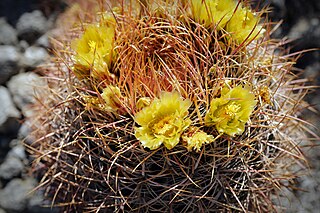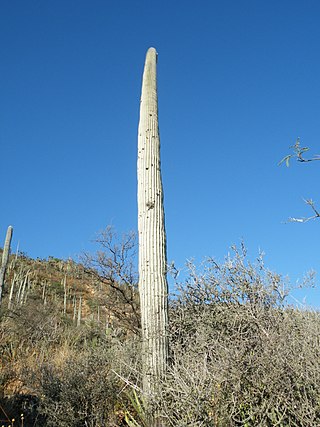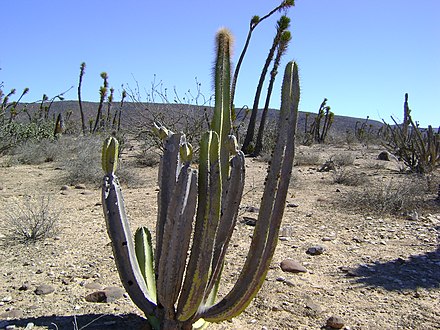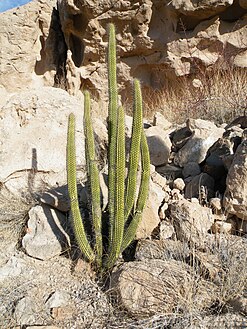
Pachycereus pringlei is a species of large cactus native to northwestern Mexico, in the states of Baja California, Baja California Sur, and Sonora. It is commonly known as cardón, a name derived from the Spanish word cardo, meaning "thistle"; additionally, it is often referred to as sabueso, which is possibly an early Spanish interpretation of the native Seri term for the plant, xaasj.

Lophocereus is a genus of cacti. It has often been merged into the genus Pachycereus, but was separated in a 2019 revision of Pachycereus, and is accepted by Plants of the World Online as of March 2021.

Mitrocereus is a monotypic genus of cacti. Its sole species is Mitrocereus militaris, native to Mexico.

Echinocereus engelmannii, the strawberry hedgehog cactus or Engelmann's hedgehog cactus, is a cactus commonly found in desert areas of the southwestern United States and the adjacent areas of Mexico, including the states of California, Nevada, Utah, Arizona, Baja California and Sonora.

Ferocactus cylindraceus is a species of barrel cactus which is known by several common names, including California barrel cactus, Desert barrel cactus, compass barrel cactus, and miner's compass. It was first described by George Engelmann in 1853.

Ferocactus echidne is a barrel cactus in the genus Ferocactus. It is found in nature in Mexico. This cactus is known commonly as Sonora barrel, Coville's barrel cactus, Emory's barrel cactus, and traveler's friend. This plant is often sold as a houseplant.

Ferocactus viridescens is a species of flowering plant in the cactus family Cactaceae. This rare barrel cactus is known by several common names, including coast barrel cactus, keg cactus and San Diego barrel cactus. Most of its native range in the United States is in San Diego County, California, where it is threatened by development, agriculture, and other alterations in its habitat. It is also found in northern Baja California, Mexico.

Upiga is a monotypic moth genus described by Hahn William Capps in 1964. The genus is placed in the family Crambidae, but has also been placed in Pyralidae. It contains only one species, Upiga virescens, the senita moth, described by George Duryea Hulst in 1900 and found in the Sonoran Desert of North America.

Lophocereus marginatus is a species of plant in the family Cactaceae. It is sometimes called Mexican fencepost cactus.

Cylindropuntia echinocarpa is a species of cactus known by the common names silver cholla, golden cholla, and Wiggins' cholla. It was formerly named Opuntia echinocarpa.

Ferocactus peninsulae is a barrel cactus in the genus Ferocactus of the family Cactaceae.

Pachycereus pecten-aboriginum is a columnar cactus plant native to Mexico. They can grow up to 15 m (49 ft) high. The trunk of this species is 1.2 to 5.0 m tall and the fruits are large and burr-like. The specific name, pecten-aboriginum, is from the Latin, and means "native combs". It was inspired by the use of the fruits as hair combs.

Ferocactus emoryi, known commonly as Emory's barrel cactus, Coville's barrel cactus and traveler's friend, is a barrel cactus in the genus Ferocactus.

Ferocactus chrysacanthus, commonly known as the Cedros barrel cactus, is an endangered species of cactus endemic to the islands of Cedros and West San Benito off the Pacific coast of Baja California, Mexico.

Ferocactus diguetii, commonly known as the giant barrel cactus, is the largest species of barrel cactus in the genus Ferocactus. It is an insular species endemic to several of Baja California Sur's southern islands in the Gulf of California. As the superlative giant of the barrel cacti, it reaches heights of up to 4 metres (13 ft) and diameters of 1 metre (3.3 ft) in the wild, a result of island gigantism. The species has red flowers that bloom from March to May. Although restricted in range, this species grows in protected habitat and lacks major threats.

Ferocactus gracilis, the fire barrel cactus, is a species of Ferocactus from Northwestern Mexico. This cactus gets its common name from the striking red coloration of its defensive spines and flowers.

Pelecyphora macromeris, the nipple beehive cactus, is a species of cactus in the United States and Mexico. In the Chihuhuan Desert, it is common and has a wide range.

Myrtillocactus cochal, the cochal or candelabra cactus, is a species of flowering plant in the family Cactaceae, native to the Baja California peninsula. Individuals can reach 3 m (10 ft), and are hardy to USDA zone 9b.

Cephalocereus columna-trajani is a species of cactus from Mexico.

Lophocereus gatesii is a species of plant in the family Cactaceae.



























